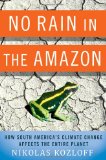 Three months after Simon Lewis laid a complaint with the UK’s Press Complaints Commission, which I reported here, the Sunday Timeshas retracted Jonathan Leake’s disgraceful Amazongate article and apologised to Dr Lewis. The article has been removed from their website. Here’s the apology:
Three months after Simon Lewis laid a complaint with the UK’s Press Complaints Commission, which I reported here, the Sunday Timeshas retracted Jonathan Leake’s disgraceful Amazongate article and apologised to Dr Lewis. The article has been removed from their website. Here’s the apology:
The article “UN climate panel shamed by bogus rainforest claim” (News, Jan 31) stated that the 2007 Intergovernmental Panel on Climate Change (IPCC) report had included an “unsubstantiated claim” that up to 40% of the Amazon rainforest could be sensitive to future changes in rainfall. The IPCC had referenced the claim to a report prepared for WWF by Andrew Rowell and Peter Moore, whom the article described as “green campaigners” with “little scientific expertise.” The article also stated that the authors’ research had been based on a scientific paper that dealt with the impact of human activity rather than climate change.
In fact, the IPCC’s Amazon statement is supported by peer-reviewed scientific evidence. In the case of the WWF report, the figure had, in error, not been referenced, but was based on research by the respected Amazon Environmental Research Institute (IPAM) which did relate to the impact of climate change. We also understand and accept that Mr Rowell is an experienced environmental journalist and that Dr Moore is an expert in forest management, and apologise for any suggestion to the contrary.
The article also quoted criticism of the IPCC’s use of the WWF report by Dr Simon Lewis, a Royal Society research fellow at the University of Leeds and leading specialist in tropical forest ecology. We accept that, in his quoted remarks, Dr Lewis was making the general point that both the IPCC and WWF should have cited the appropriate peer-reviewed scientific research literature. As he made clear to us at the time, including by sending us some of the research literature, Dr Lewis does not dispute the scientific basis for both the IPCC and the WWF reports’ statements on the potential vulnerability of the Amazon rainforest to droughts caused by climate change.
In addition, the article stated that Dr Lewis’ concern at the IPCC’s use of reports by environmental campaign groups related to the prospect of those reports being biased in their conclusions. We accept that Dr Lewis holds no such view – rather, he was concerned that the use of non-peer-reviewed sources risks creating the perception of bias and unnecessary controversy, which is unhelpful in advancing the public’s understanding of the science of climate change. A version of our article that had been checked with Dr Lewis underwent significant late editing and so did not give a fair or accurate account of his views on these points. We apologise for this.
Leake’s article was not only celebrated ad nauseam in the denialist community but also taken up by mainstream media in many countries. Here in New Zealand the Dominion Post used it in an editorial claiming that the ethics and integrity of climate scientists is being called into question. I wrote about that here. The editorial accepted that human activity is contributing to global warming, but drew this appalling conclusion about the IPCC:
“Why trust a panel that confuses opinion and fact, wrongly attributes that opinion, tries to shout down critics and displays a determination to make the facts fit the theory rather than the other way around.
“The IPCC should leave the spin to the politicians and get on with its real job – establishing the facts. By glossing over inconvenient truths and misrepresenting opinion as scientific fact, it has undermined its credibility.
“It now has a great deal of work to do if it is to persuade peoples and governments that its findings should be taken seriously.”
Jonathan Leake and the Sunday Times have a lot to answer for, but so do journalists in many places who allow themselves to be so easily misinformed. The credulity with which they have received accusations of malpractice by the East Anglia scientists, and alleged IPCC errors (beyond the acknowledged and regretted error relating to the Himalayan glaciers) is astonishing. Where on earth did the Dominion Post find the confidence to make such a declaration about the IPCC? Not by reading the science, that’s for sure. And that’s the nub of the matter: the media generally gives the impression that it has not ensured that enough of its journalists are informed about climate science. That’s why the mischief wrought by disinformers, especially when they’re backed by seemingly reputable papers, can reach global media proportions overnight.
Perhaps any of our readers who see the Dominion Post might consider writing to the editor and inviting them to retract their editorial, or at least to write another acknowledging that they have reason to reconsider their verdict on the IPCC.
The Sunday Times correction has been published on their website here, but be warned that you have to go through a full registration procedure to view it.


 During the Copenhagen kerfuffle a lot of interesting stuff hit the web: here’s something that deserves a bit more air – a Proceedings of the National Academy of Science (PNAS)
During the Copenhagen kerfuffle a lot of interesting stuff hit the web: here’s something that deserves a bit more air – a Proceedings of the National Academy of Science (PNAS)